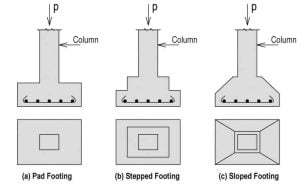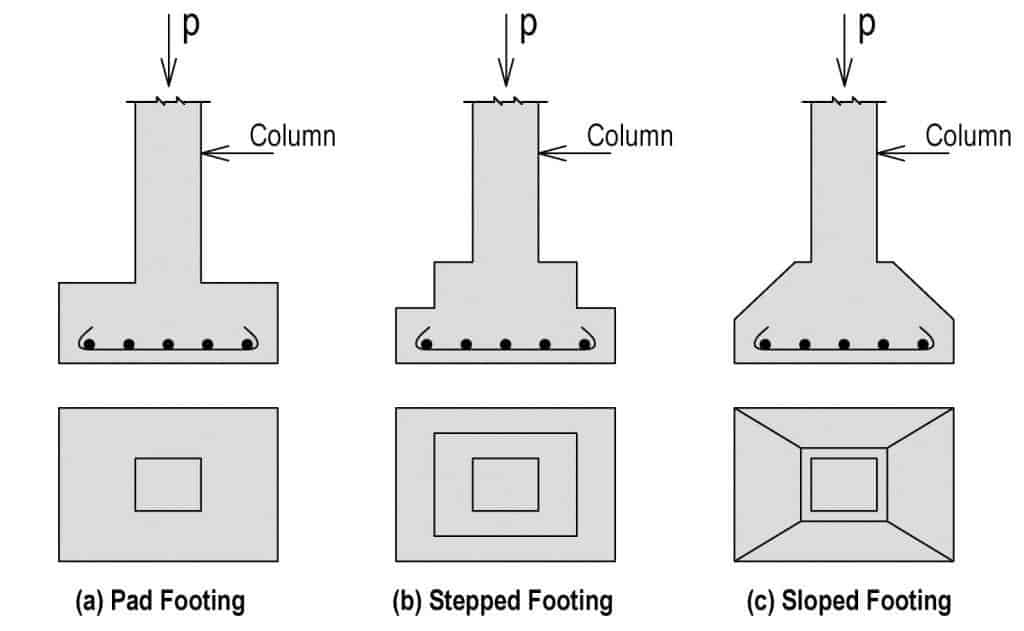Table of Contents
In this article, we will discuss spread footing.
The spread footing is used to hold the column & walls and also to carry & spread the load lying to the structure to the soil under it. The loads are given within the upward direction, this footing really acts as an inverted cantilever, and this sort of footing is typically a rigid element & they’re orthogonal just in case of symmetric footing.
1. Spread Footing/Pad Footing
This footing is also known as pad foundation. In this type of foundation, the base is made wider than the top to distribute the load from the superstructure over a large area.
This type of foundation is suitable for walls and masonry columns.
These foundations are constructed after opening the trenches to the required depth.
It is economical for a maximum depth of 3 m.
While constructing this type of footing trenches are opened to the required depth and the soil is rammed well. Then a plain concrete mix 1:4:8 is placed. Its thickness differs from 150 to 200 mm. The stone-masonry footing is constructed over this bed. It is constructed in courses and each course is projected 50 to 75 mm from the top course and the height of each course is 150 to 200 mm.
In the case of wall footing, the projections are provided only in one direction while in the case of columns, they are provided in both directions.
The projection of bed concrete from the lowest course of foundation masonry is usually 150 mm.
2. Types of Spread Footing
There are 6 types of spread footing. They are:

1. Isolated Column Footings / Isolated Footings
Separate footings are built for each column in isolated column footings.
For distributing the load of the columns safely and uniformly over the soil, the size of the footing is kept according to the area required.
Such type of footings is usually constructed over 100 or 150 mm concrete bed.
Design engineers evaluate the required reinforcement and thickness of footing.
Footing thickness may be uniform or sometimes varying.

2. Combined Footings
In this type of footings, two or more columns are supported by a single base.
This type of footing is required when a column is extremely close to the boundary of the property and hence it is worthless to provide footing much beyond the column face.
This footing may be rectangular or trapezoidal.
The footing should be designed and constructed to transfer loads from both columns safely to the soil.
A strap beam is provided for connecting two columns.

3. Continuous Footings
In continuous footings, a footing is common for more than two columns in a row.
In case the columns in a row are nearer or if the Soil Bearing Capacity of soil is low, the continuous footing will be more applicable.
The continuous footing is used when;
i. The load-bearing capacity of soil is low.
ii. The columns are too close to each other and their individual footing will overlap.

4. Grillage Footing
Most high-rise buildings are constructed with steel columns encased in concrete. Such types of columns carry a very heavy load and hence it requires special foundations for spreading the entire load to a larger area of soil.
So Grillage foundation is one such special foundation that is used where the load of the structure is excessive and the bearing capacity of the soil is poor and a deep foundation is not possible.
It has one tier or more tiers of I-section steel beams.
The top tiers consist of fewer numbers but large steel sections while the lower tier consists of larger numbers but smaller size steel sections.
Through the baseplate; column load is transferred to the top tier.
The unpainted grillage beams are enclosed in concrete beyond the edge of steel sections with a minimum cover of 100 mm.
A minimum clear space of 75 mm is required to be kept between the flanges of adjacent grillage beams which ensures proper concreting.
Pipe separators are used to maintain spacing.

5. Raft Footing
Whenever the load on the column is extensive (multi-story column) or when the SBC of the soil is low, the foundations overlap each other.
In such a situation, it is beneficial to provide common footing to several columns and this footing is called mat footing.
Load distribution is uniform in this footing.
It is also called raft footings.
The raft foundation in which the beams are built in both directions over the footing slab for connecting columns may be called a grid foundation. The settlement is uniform in this type of footing and hence unnecessary stresses are not developed.

6. Strip Footing
Strip footing is the independent footing of two columns connected by a beam. It is of four types.
They are:
1. Wall footing
2. Inverted arch footing
3. Eccentrically loaded footing
4. Offset and strap (cantilever) footing
1. Inverted Arch Footing
This type of foundation is applicable for the areas where the SBC of the soil is incredibly poor and the load of the structure is through walls.
Thus, inverted arches are built between the walls.
End walls should be able to withstand the outward horizontal thrust due to arch action. So, it should be sufficiently thick and strong.
The outer walls may be provided with buttress walls to strengthen them.
2. Eccentrically Loaded Footing
As far as practicable, the foundation should be so shaped and proportioned in such a way that center of gravity of the imposed loads coincides with the C.G of the supporting area of the base.
But the footing which is so shaped that the center of gravity does not coincide with the C.G of the supporting area of the base is known as eccentrically loaded footing.

3. Uses of Spread Footings
The uses of these types of footing are as follows:
a. It is utilized to hold a foundation or number of piers beneath a building.
b. Provides Stability
c. Reduce the unequal settlement of the building
d. Transmits the load from the superstructure to the ground.
4. Advantages of Spread Footings
The advantages of spread Footings are as follows:
a. It decreases cracking bring out by settlement.
b. It balances soil around the base of the structure.
c. Easy construction of basements.
d. It has continuous contact with the whole foundation which decreases the risk of foundation collapse.
e. Cost savings in construction, design, and quality control.
5. Disadvantages of Spread Footings
The disadvantages of spread footings are as follows:
a. It is restricted to certain soil structures only and cannot be utilized for all forms of soil.
b. This type of foundation is regularly put through torsion, moment, and pullout.
c. Settlement is a huge problem in this type of foundation.

